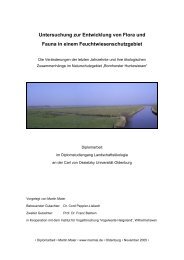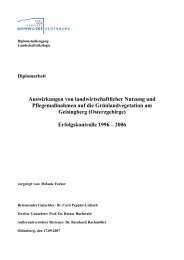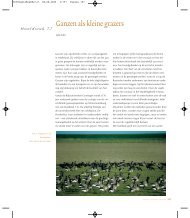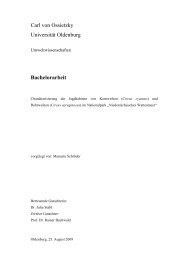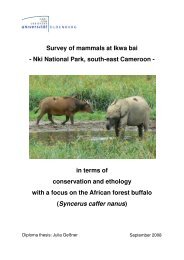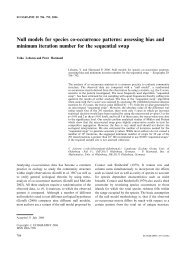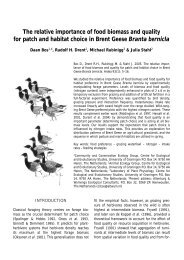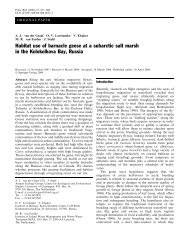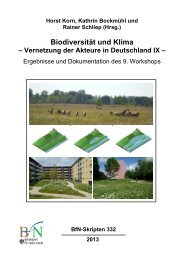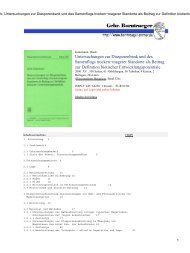The use of habitat models in conservation of rare and endangered ...
The use of habitat models in conservation of rare and endangered ...
The use of habitat models in conservation of rare and endangered ...
You also want an ePaper? Increase the reach of your titles
YUMPU automatically turns print PDFs into web optimized ePapers that Google loves.
254<br />
Cover <strong>of</strong> Festuca rubra / F. ov<strong>in</strong>a [%]<br />
0% 40% 70%<br />
1<br />
1<br />
1<br />
P<br />
P<br />
P<br />
0<br />
35<br />
100<br />
0<br />
35<br />
100<br />
0<br />
35<br />
100<br />
Age<br />
[years]<br />
0<br />
Moss<br />
Cover [%]<br />
Age<br />
[years]<br />
0<br />
Moss<br />
Cover [%]<br />
Age<br />
[years]<br />
0<br />
Moss<br />
Cover [%]<br />
Figure 3. Best <strong>habitat</strong> model for Rhopalopyx vitripennis. Occurrence probability (P) on the z-axis, aga<strong>in</strong>st age <strong>and</strong> moss cover. Three<br />
levels <strong>of</strong> Festuca rubra/ov<strong>in</strong>a-cover are represented <strong>in</strong> the three diagrams.<br />
Cover <strong>of</strong> Corynephorus canescens [%]<br />
Proportion <strong>of</strong> brownfields with grassy, sparse vegetation with<strong>in</strong> 75m [%]<br />
0%<br />
40%<br />
80%<br />
1<br />
P<br />
1<br />
P<br />
1<br />
P<br />
0<br />
12<br />
50%-<br />
Height [cm]<br />
0<br />
12<br />
50%-<br />
Height [cm]<br />
0<br />
12<br />
50%-<br />
Height [cm]<br />
0% 15% 30%<br />
Litter<br />
Cover [%]<br />
0<br />
1<br />
1<br />
P<br />
P<br />
0<br />
0<br />
100<br />
12<br />
100<br />
12<br />
50%-<br />
Litter<br />
50%-<br />
Height [cm]<br />
Cover [%]<br />
Height [cm]<br />
0<br />
0<br />
Litter<br />
50%-<br />
Cover [%]<br />
Height [cm]<br />
0<br />
1<br />
P<br />
0<br />
100<br />
12<br />
Litter<br />
50%-<br />
Cover [%]<br />
Height [cm]<br />
0<br />
1<br />
P<br />
0<br />
100<br />
12<br />
0<br />
0<br />
Litter<br />
50%-<br />
Cover [%]<br />
Height [cm]<br />
0<br />
1<br />
P<br />
0<br />
100<br />
12<br />
Litter<br />
50%-<br />
Cover [%]<br />
Height [cm]<br />
0<br />
1<br />
P<br />
0<br />
100<br />
12<br />
100<br />
Litter<br />
Cover [%]<br />
100<br />
Litter<br />
Cover [%]<br />
100<br />
Litter<br />
Cover [%]<br />
Figure 4. Best <strong>habitat</strong> model for Neophilaenus m<strong>in</strong>or. In each diagram, P is plotted aga<strong>in</strong>st 50%-Height <strong>and</strong> litter cover. Columns<br />
represent different levels <strong>of</strong> Corynephorus canescens-cover <strong>and</strong> rows represent different proportions <strong>of</strong> BGS75.<br />
context might be due to two factors. First, most<br />
Auchenorrhyncha species seem to not need large<br />
sites to build up viable populations (Biedermann<br />
2002, 2004; Cron<strong>in</strong> 2004). Second, it is likely that<br />
for Auchenorrhyncha, most brownfield sites are<br />
not truly isolated. Small patches <strong>of</strong> potential<br />
<strong>habitat</strong> are found along most roads <strong>and</strong> tracks <strong>and</strong><br />
connect the larger sites.<br />
Overall, univariate responses <strong>of</strong> all four species<br />
corresponded well to <strong>habitat</strong> requirements<br />
described <strong>in</strong> Nickel (2003). For <strong>in</strong>stance,<br />
M. quadripunctulatus is regarded as a pioneer<br />
species preferr<strong>in</strong>g s<strong>and</strong>y, sparsely vegetated <strong>and</strong><br />
moderately dry to dry sites. This agrees with our<br />
results that the species was restricted to young sites<br />
with very scarce vegetation.




